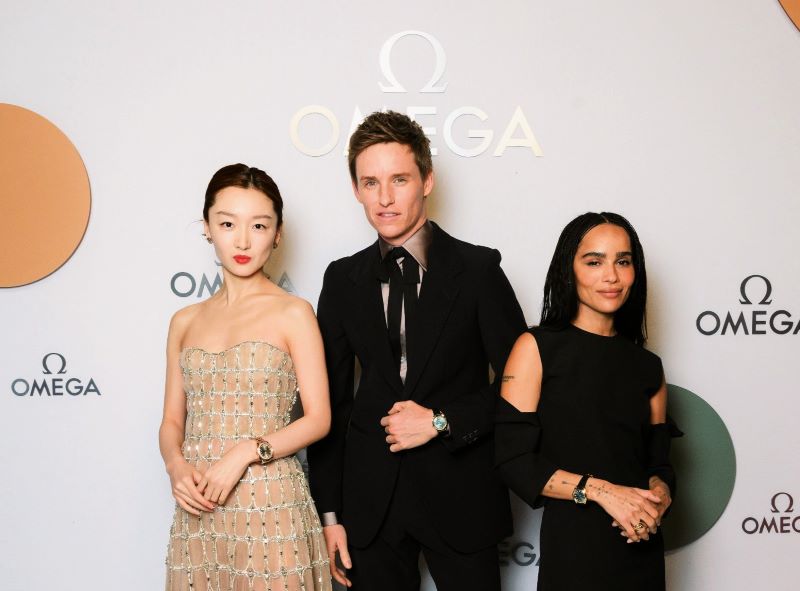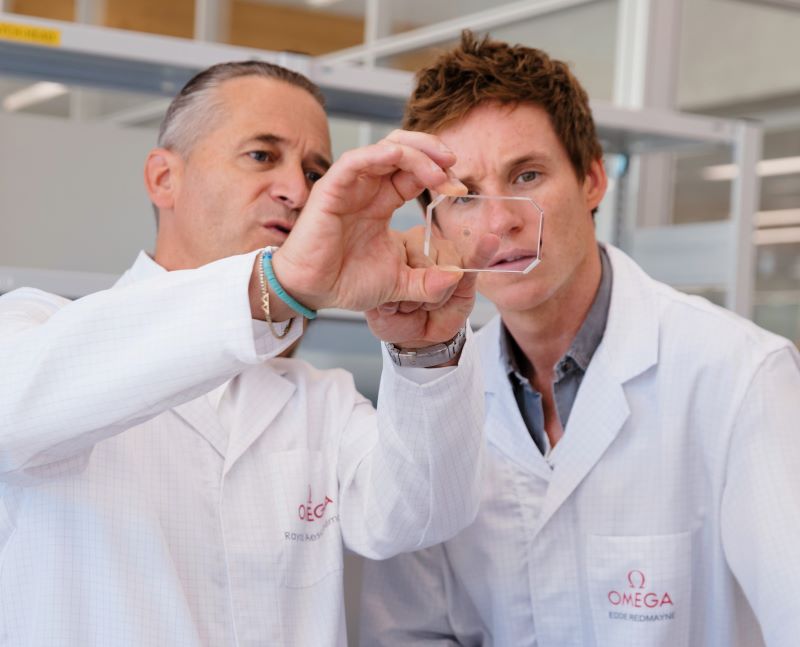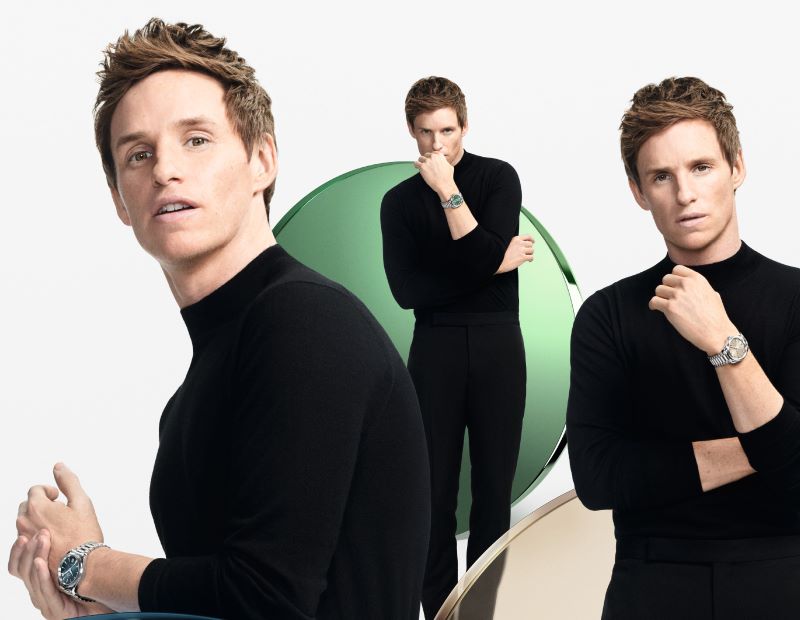
Redmayne wears the Omega Seamaster Aqua Terra 150M Co-Axial Master Chronometer 34mm (All photos: Omega)
The freckled, boyish lead of blockbuster films such as the Fantastic Beasts series and 2015 Oscar winner for The Theory of Everything, 41-year-old Eddie Redmayne has been an Omega ambassador for eight years now. The actor shares more about his red carpet style as well as his penchant for horology in this special interview.
Options: Your red carpet looks have been amazing of late. Tell us about this transition from traditional tuxedos to a more fashion-forward approach.
Eddie Redmayne: One of the wonders of our job is playing dress-up. It’s one of the reasons you get into acting when you’re a kid — the transforming and the theatre of it. I have always been riveted by fashion. I’ve always enjoyed styling myself, being playful. But I have had two children and a big press tour for The Good Nurse, so I didn’t have enough time to go organise myself. I had wanted a new set of eyes for that and had seen Harry Lambert, my stylist. He has worked with Josh O’Connor, who’s one of my favourite actors, and Emma Corrin, and I just thought the work he had done with them was so intriguing. There was a classicism to it but also playful. I asked Harry if he would be up for it, and he was. I’ve been really trying to re-embrace the fact that the red carpet is theatre and you can enjoy it.
How does Omega fit in with your new red carpet style?
It’s been quite effortless, really. I will choose what to wear and I am lucky there is such variety with what Omega does. There is always something that seems to sing with what you are wearing.
Where does your style inspiration come from?
It’s always shifting. I was just in Paris for the [Alexander] McQueen show. Sarah [Burton, the designer] is an old friend. So, getting to see all these amazing Leonardo da Vinci drawings, some striations of muscle, and seeing how she then transfers them onto fabric with beads is a thrilling privilege. As an actor, you get to dip into these different worlds.
omega_aqua_terra_shades_london.jpg

Have you always worn watches?
Always. I got a Flik Flak when I was about five and my children have Flik Flaks too. But my father, an elegant man, had an Omega De Ville — very beautiful, very classic and very much a treasured thing. When I started wearing watches, the [Omega De Ville] was what I was aspiring to. One of the joys I found with Omega was that there is so much storytelling. It has such a ripe history. And I was lucky enough to go to Biel [Switzerland, where the Omega factory is] last year and see the intricacy of the craftsmanship involved in telling these stories.
Because your dad owned an Omega, do you think of watches as heirlooms?
When you see the watches being made, you realise how much time and craftsmanship go into their making. And although they are beautiful things, it made me appreciate them even more. It’s nostalgia, seeing a watch on your parent’s wrist as a child, and you connect to that. My visual memories as a kid of seeing him with the watch, taking it off before swimming … it was a very valued thing. I am lucky to have a very beautiful collection of Omega watches and I just hope my son has the same wrist size.
What’s your take on men and smaller watch sizes?
I think it’s all proportionate. Despite my best efforts to hit the gym and have massive forearms, I’m not sure I can pull off a Daniel Craig style. I have always preferred proportionate-scaled watches and that is one of the reasons I love this new Aqua Terra range. It instantly felt like a good fit. My wife loves wearing men’s watches, wearing them like a piece of jewellery … a bangle almost. And I’m like, ‘Can we share watches?’
What do you feel is the most important element of a watch? Is it design or function?
I am not a huge jewellery fan. I don’t wear rings or bracelets. So, a watch is the one piece of jewellery I can make gentle statements through. I love how Omega does that with an elegance, classicism and vibrancy of personality. You can often wear something simple and let the watch do the talking. I also think it’s really important that watches function incredibly well. I never was a digital man but, certainly, with things like phones and all the magnetism we have now — which can screw up watches — the Master Chronometer element of what Omega did was pretty important.
omega_eddieredmayne_visitshq_factory_raeschlimann.jpg

You’ve been with Omega for eight years. What do you love most about the brand?
My relationship started, obviously, through my family wearing Omega. I remember one of the first Omega events I attended was when I was doing The Theory of Everything. It was in London and Cindy Crawford was hosting it. I remember Jessica Ennis was there too and I got to meet all these sports people.
At the time, I didn’t realise Omega was woven into so many different parts of culture. I was used to the movie star elements of it — you know, with George Clooney and all — but [what I love most is] getting to know the sporting element, the science of timekeeping and going to Switzerland, seeing what an extraordinary place it is. Also to see the intricacy of the workmanship and how the watchmakers work on shifts of a couple of hours because the concentration needed when they’re dealing with elements that miniscule is overwhelming.
What do you think of Omega’s new Aqua Terra Shades and which is your favourite?
The Aqua Terra Shades have a gentle elegance to them and yet they sing. They have a punch above simplicity. I love that with these new colours, there’s a vibrancy that just makes them pop! I love the Sandstone, which I’m wearing now, and also the Terracotta.
Do you agree that different colours present different emotions?
Colour definitely evokes things in me. When I was in China with Omega, there was an extraordinary event at an art museum. They’d asked if I wanted to see what was going on upstairs, which I did. On the first floor was an exhibition by Yves Klein, a French artist obsessed with the colour blue. He had created this pigment which he patented and copyrighted called International Klein Blue. In university, I wrote my history of art dissertation on this colour. So, when I walked up and saw an entire exhibition of this artist and this colour [before me], my knees just buckled. It was amazing. It is [still] a very emotional colour.
Of all the roles you’ve played, which movie best reflects the idea that time is precious?
Gosh, probably The Theory of Everything. With a degenerative disease, you are given a time limit on your life and instantly throw out the notion of what time means. It certainly did for Stephen Hawking. He and his wife Jane married at age 21 with the belief he had two years to live, maximum. And he lived for over 50.
Another example would be a play I did called Richard II, where one of the last lines is ‘I wasted time and now time doth waste me’. The idea of not wasting time, of really filling every moment, is exacerbated when you know there’s a limitation to it.
unnamed.jpg

Time is the ultimate luxury. What do you do to protect yourself from stress?
As we grow older, it’s about learning about yourself. I do the best work when I get fully immersed in it. And that can take a lot of time. Often with films, you don’t have the luxury of that. I haven’t really been an actor who goes from job to job. I take time out to be with my family, to live a normal life and to replenish the soul before jumping back into things — and it’s a great luxury. Not all actors have that and I may not have it in a few years’ time. But for the moment, it’s wonderful.
If you had an extra hour, today or tomorrow, what would you do?
Play the piano. I’m not particularly good but I’ve played it all my life. And when I try to practise, it’s so all-consuming you can’t think of anything else. That’s good for me as it sort of takes me out of my head for a bit.
And do you have a special Omega moment to share?
Getting to go to the Olympics in Brazil [2016]. It was very soon after my daughter was born. She was eight weeks old and she came with us. She still has the lanyard. When you are educated on the science of timekeeping, you realise what a responsibility that is. I remember being taken down by one of the leading scientists to see the pads [the athletes] hit at the end of the swimming pools. The science and technology behind them were extraordinary.
at36_x348_220.10.38.20.03.jpg

What are you working on right now?
I’m starting preparation for Day of the Jackal, a new television series based on the Frederick Forsyth book and in which languages are involved. For the first time in my life, I’m embarking on [learning] a tiny bit of Spanish, which is proving substantially harder than I had expected. I have relatives in Spain so, hopefully, my cousins will be my dialect coaches. I’m an addict of long-form television and the intricacy and depth of these characters sit with you for weeks on end.
Since doing Cabaret [in the West End], which re-galvanised my love for what I do, I was waiting to see what would really inspire me. Then these scripts came along and they were written by a brilliant man called Ronan Bennett. With each episode I read, I was desperate for the next — they were thrilling! We don’t start shooting for a bit, but in the prep for it, I am hoping it’ll be something super special.
You once mentioned you love watching James Bond but would hate playing the character. Is that still true?
Yeah. You don’t want to see yourself butcher your favourite thing. It’s like meeting your heroes, you know? I always think you know what your boundaries are. I love James Bond but I’d rather watch someone else [play him]. However, seeing as I’m about to play another assassin, maybe I am fulfilling some part of that [wish].
This article first appeared on Apr 10, 2023 in The Edge Malaysia.


